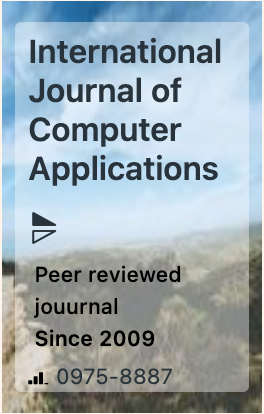The week's pick
Random Articles
Reseach Article
Predicting Meteorological Data using Machine Learning
| International Journal of Computer Applications |
| Foundation of Computer Science (FCS), NY, USA |
| Volume 187 - Number 9 |
| Year of Publication: 2025 |
| Authors: Syed Hamid Ali Shah, Rameez Asif |
 10.5120/ijca2025925007
10.5120/ijca2025925007
|
Syed Hamid Ali Shah, Rameez Asif . Predicting Meteorological Data using Machine Learning. International Journal of Computer Applications. 187, 9 ( May 2025), 23-29. DOI=10.5120/ijca2025925007
Abstract
Understanding the nature and behavior of weather has always been an essential task for humans, as it has a significant impact on the property and economy of a country. Machine Learning algorithms can predict the patterns of the weather nature i.e. floods, hurricanes, storms, cyclones, and rain. This paper looks at applying machine learning techniques to predict target variables i.e. precipitation to independent variables i.e. wind speed, temperature, pressure, and soil temperature for three years of weather data collected from the Manchester region that is publicly available on the OpenMeteo website. The objective of this research is to evaluate and compare the accuracy, precision, F1 score, and recall of linear regression, support vector machine regression, k-nearest neighbor regression, and random forest regression algorithms using Python,starting with preprocessing the data, developing the algorithms, training, and finally testing it. The low mean squared error (MSE), R² score, and mean absolute error (MAE) illustrate the ability of these algorithms for prediction. Further analysis of these algorithms shows linear and support vector machine regression with 92.2% and 92.5% accuracy.
References
- Mark Holmstrom, Dylan Liu, Christopher Vo, “Machine Learning Applied to Weather Forecasting” Stanford University, 2016.
- Young, M.V. and Grahame, N.S. (2022). The history of UK weather forecasting: the changing role of the central guidance forecaster. Part 2 : the birth of operational numerical weather prediction. Weather.
- Zhao, Q., Liu, Y., Yao, W. and Yao, Y. (2022). Hourly Rainfall Forecast Model Using Supervised Learning Algorithm. IEEE Transactions on Geoscience and Remote Sensing, 60, pp.1–9.
- Chen, L., Han, B., Wang, X., Zhao, J., Yang, W. and Yang, Z. (2023). Machine Learning Methods in Weather and Climate Applications: A Survey. Applied Sciences, 13(21), p.12019.
- Zhang, H., Liu, Y., Zhang, C. and Li, N. (2025). Machine Learning Methods for Weather Forecasting: A Survey. Atmosphere, [online] 16(1), pp.82–82.
- Wang, J., Wang, Z., Ye, J., Lai, A., Ma, H. and Zhang, W. (2023). Technical Evaluation of Precipitation Forecast by Blending Weather Radar Based on New Spatial Test Method. Remote Sensing, 15(12), p.3134.
- Ashok, S.P. and Pekkat, S. (2022). A systematic quantitative review on the performance of some of the recent short-term rainfall forecasting techniques. Journal of Water and Climate Change, 13(8), pp.3004–3029.
- Verma, S., Srivastava, K., Tiwari, A. and Verma, S. (2023). Deep Learning Techniques in Extreme Weather Events: A Review. [online] arXiv.org.
- Mukkavilli, S.K., Civitarese, D.S., Schmude, J., Jakubik, J., Jones, A., Nguyen, N., Phillips, C., Roy, S., Singh, S., Watson, C., Ganti, R., Hamann, H., Nair, U., Ramachandran, R. and Weldemariam, K. (2023). AI Foundation Models for Weather and Climate: Applications, Design, and Implementation. [online] arXiv.org.
- Pathak, J., Subramanian, S., Harrington, P., Raja, S., Chattopadhyay, A., Morteza Mardani, Kurth, T., Hall, D.H., Li, Z., Kamyar Azizzadenesheli, Hassanzadeh, P., Karthik Kashinath and Animashree Anandkumar (2022). FourCastNet: A Global Data-driven High-resolution Weather Model using Adaptive Fourier Neural Operators. arXiv (Cornell University).
- Mounia El Hafyani, Khalid El Himdi and Salah-Eddine El Adlouni (2024). Improving monthly precipitation prediction accuracy using machine learning models: a multi-view stacking learning technique. Frontiers in Water, 6.
- García-Vázquez, F., Ponce-González, J.R., Guerrero-Osuna, H.A., Carrasco-Navarro, R., Luque-Vega, L.F., Mata-Romero, M.E., Martínez-Blanco, M. del R., Castañeda-Miranda, C.L. and Díaz-Flórez, G. (2023). Prediction of Internal Temperature in Greenhouses Using the Supervised Learning Techniques: Linear and Support Vector Regressions. Applied Sciences, [online] 13(14), p.8531.
- Abdulraheem, M.; Awotunde, J.B.; Abidemi, E.A.; Idowu, D.O.; Adekola, S.O. Weather prediction performance evaluation on selected machine learning algorithms. IAES Int. J. Artif. Intell. 2022, 11, 1535
- Suman Markuna, Kumar, P., Ali, R., Dinesh Kumar Vishwkarma, Kuldeep Singh Kushwaha, Kumar, R., Vijay Kumar Singh, Chaudhary, S. and Alban Kuriqi (2023). Application of Innovative Machine Learning Techniques for Long-Term Rainfall Prediction. Pure and applied geophysics, 180(1), pp.335–363.
- Open-meteo.com. (2022). Docs | Open-Meteo.com. [online] Available at: https://open-meteo.com/en/docs#latitude=53.4809&longitude=-2.2374 [Accessed 1 Sep. 2024.
Index Terms
Keywords

